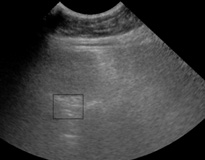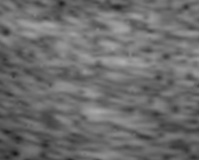Spinal ultrasound in a “difficult” patient
We have several projects aimed at improving the overall image quality of ultrasound images. The main concept underlying this research is to obtain multiple images of an anatomical region from different points of view and then compound (combine) these images together into a single image that highlights the anatomical features while reducing the level of noise. This is called spatial compounding because the ultrasound beams are swept spatially to achieve different viewpoints. Although the concept of averaging multiple measurements of a signal to reduce noise is well-known in other areas, we were one of the first to perform this technique on 3D ultrasound. The key behind the success of spatial compounding is accurate image alignment, also called image registration.
Currently, we are developing more advanced methods of aligning and combining the multiple images together. In particular, we were the first to introduce non-rigid warping of the images to achieve a more accurate alignment. A better alignment means that small features are not blurred out by the process of combining the images together. In this research, we collaborate with Ultrasonix Medical where they provide access to the internal image processing pipeline in the ultrasound machine. This unique research interface allows us to make changes to the low-level control and processing of the ultrasound signals. It also allows us to implement the techniques directly on the ultrasound machine for live demonstrations. This impact of this work is high because tests showed a significant improvement in image quality that can be applied to almost all clinical areas. This work was awarded the Cum Laude award for the best poster presentation at the 2004 Medical Imaging conference, one of the largest conferences in the field of medical imaging.

c) Cropped with of adaptive spatial compounding. The target epidural space is shown as pair of short horizontonal lines just below the middle of the cropped image.
This work continues to be expanded, and recent work has shown it can be specialized for improving epidural needle insertions and visibility of biopsy needles. The key behind the most recent extensions of this work is the concept of “adaptive imaging” where the image quality can be optimized frame-by-frame through high speed computations of alignment and data compounding.
We have recently been awarded an Innovation and Commercialization Strategic Development Grant by the BC Innovation council to extend the concept of 3D spatial compounding and image alignment with optical images of the eye. That grant is in collaboration with Peking University who provide expertise on laser optics.

